Blog & Latest Updates
Fly Fishing Articles
Insects by Common Name


Arthropod Class Insecta (Insects)
Taxonomic Navigation -?-
1 order isn't included.
Common Name
| Match | Common Name |
| Insects |
This is page 95 of specimens of Insecta. Visit the main Insecta page for:
- The behavior and habitat of Insecta.
- 114 underwater pictures of Insecta.
Pictures of 1229 Insect Specimens:
Epeorus longimanus (Slate Brown Dun) Mayfly Nymph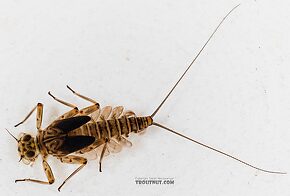 View 9 Pictures
View 9 Pictures
 View 9 Pictures
View 9 PicturesCollected July 4, 2020 from Mystery Creek #249 in Washington
Added to Troutnut.com by Troutnut on July 12, 2020
Added to Troutnut.com by Troutnut on July 12, 2020
Leptoceridae Caddisfly Adult View 17 PicturesThis specimen keyed easily to Leptoceridae, but I hit a bit of a dead end in the genus key, because I can't seem to find the cross-veins in the wings that are supposed to help narrow it down. I took pictures of all the relevant features under the microscope; maybe somebody with more experience with the family can help.
View 17 PicturesThis specimen keyed easily to Leptoceridae, but I hit a bit of a dead end in the genus key, because I can't seem to find the cross-veins in the wings that are supposed to help narrow it down. I took pictures of all the relevant features under the microscope; maybe somebody with more experience with the family can help.
 View 17 PicturesThis specimen keyed easily to Leptoceridae, but I hit a bit of a dead end in the genus key, because I can't seem to find the cross-veins in the wings that are supposed to help narrow it down. I took pictures of all the relevant features under the microscope; maybe somebody with more experience with the family can help.
View 17 PicturesThis specimen keyed easily to Leptoceridae, but I hit a bit of a dead end in the genus key, because I can't seem to find the cross-veins in the wings that are supposed to help narrow it down. I took pictures of all the relevant features under the microscope; maybe somebody with more experience with the family can help.Collected July 31, 2020 from the Henry's Fork of the Snake River in Idaho
Added to Troutnut.com by Troutnut on August 17, 2020
Added to Troutnut.com by Troutnut on August 17, 2020
Male Acerpenna pygmaea (Tiny Blue-Winged Olive) Mayfly Spinner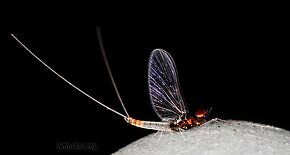 View 8 Pictures
View 8 Pictures
 View 8 Pictures
View 8 PicturesCollected August 1, 2020 from the Henry's Fork of the Snake River in Idaho
Added to Troutnut.com by Troutnut on August 18, 2020
Added to Troutnut.com by Troutnut on August 18, 2020
Formicidae (Ants) Ant Adult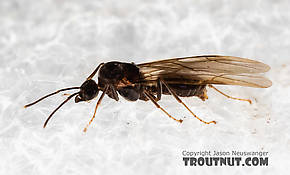 View 5 Pictures
View 5 Pictures
 View 5 Pictures
View 5 PicturesCollected August 22, 2018 from Mystery Creek #227 in Montana
Added to Troutnut.com by Troutnut on June 13, 2019
Added to Troutnut.com by Troutnut on June 13, 2019
Male Baetidae (Blue-Winged Olives) Mayfly Nymph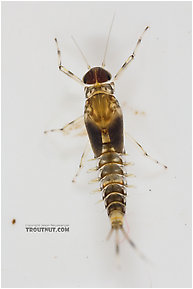 View 5 Pictures
View 5 Pictures
 View 5 Pictures
View 5 PicturesCollected May 29, 2007 from Paradise Creek in Pennsylvania
Added to Troutnut.com by Troutnut on June 4, 2007
Added to Troutnut.com by Troutnut on June 4, 2007
Male Epeorus (Little Maryatts) Mayfly Dun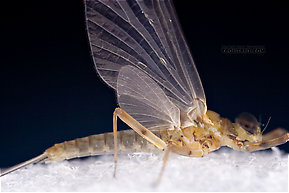 View 6 Pictures
View 6 Pictures
 View 6 Pictures
View 6 PicturesCollected May 28, 2007 from Mystery Creek #42 in Pennsylvania
Added to Troutnut.com by Troutnut on June 4, 2007
Added to Troutnut.com by Troutnut on June 4, 2007
Male Baetis tricaudatus (Blue-Winged Olive) Mayfly Spinner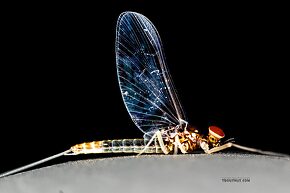 View 12 PicturesSome notes from identifying this specimen under the microscope:
View 12 PicturesSome notes from identifying this specimen under the microscope:
1. The hind wing has three longitudinal veins (Longitudinal vein: Longitudinal veins are the major long veins running length-wise through an insect's wing, connecting the base to the outer margin, or the major branches from those veins.), but the third is faint, short (about half the length of the wing), and close to the wing margin.
2. Then antenna is brown fading into white at the tip, and the base is ringed with white.
3. The joints of the tarsal segments on the middle and hind leg have fine black markings.
It was also collected in association with a female spinner.
 View 12 PicturesSome notes from identifying this specimen under the microscope:
View 12 PicturesSome notes from identifying this specimen under the microscope:1. The hind wing has three longitudinal veins (Longitudinal vein: Longitudinal veins are the major long veins running length-wise through an insect's wing, connecting the base to the outer margin, or the major branches from those veins.), but the third is faint, short (about half the length of the wing), and close to the wing margin.
2. Then antenna is brown fading into white at the tip, and the base is ringed with white.
3. The joints of the tarsal segments on the middle and hind leg have fine black markings.
It was also collected in association with a female spinner.
Collected September 4, 2020 from Silver Creek in Idaho
Added to Troutnut.com by Troutnut on September 18, 2020
Added to Troutnut.com by Troutnut on September 18, 2020
Corydalidae (Hellgrammites) Hellgrammite Larva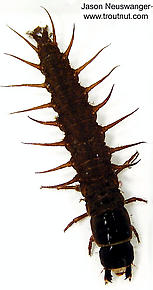 View 3 Pictures
View 3 Pictures
 View 3 Pictures
View 3 PicturesCollected March 9, 2004 from unknown in Wisconsin
Added to Troutnut.com by Troutnut on January 25, 2006
Added to Troutnut.com by Troutnut on January 25, 2006
Male Rhithrogena hageni (Western Black Quill) Mayfly Spinner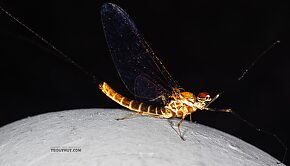 View 15 PicturesI collected this spinner from the trail (old logging road) above a whitewater canyon on a small stream in the Cascades. I'm fairly positive on the ID: in Traver 1935 it keys out to Rhithrogena doddsi, which is now a synonym (Synonym: A former name of a taxon, usually a species. Entomologists frequently discover that two insects originally described as different species are one in the same, and they drop one of the names. The dropped name is said to be a synonym of the remaining name. These changes take a while to trickle into the common knowledge of anglers; for example, Baetis vagans is now a synonym of Baetis tricaudatus.) of Rhithrogena hageni. The penes (Penes: The paired genital structures of most male insects, which vary widely in form and are one of the main characteristics used for species identification.) differ slightly from the drawing in that book, but they're a very close match to drawing from the original hageni description in Eaton 1885.
View 15 PicturesI collected this spinner from the trail (old logging road) above a whitewater canyon on a small stream in the Cascades. I'm fairly positive on the ID: in Traver 1935 it keys out to Rhithrogena doddsi, which is now a synonym (Synonym: A former name of a taxon, usually a species. Entomologists frequently discover that two insects originally described as different species are one in the same, and they drop one of the names. The dropped name is said to be a synonym of the remaining name. These changes take a while to trickle into the common knowledge of anglers; for example, Baetis vagans is now a synonym of Baetis tricaudatus.) of Rhithrogena hageni. The penes (Penes: The paired genital structures of most male insects, which vary widely in form and are one of the main characteristics used for species identification.) differ slightly from the drawing in that book, but they're a very close match to drawing from the original hageni description in Eaton 1885.
I'm using its ID to put a species ID on a female dun and mature nymph collected on the same trip. I'm also using this one's ID for a specimen with seemingly identical reproductive anatomy from Montana.
Lastly, I have included here a couple pictures of the genitalia of a different specimen collected on the same evening, from the same river, and I think even the same swarm (although I don't recall that 100 %). They're angled a bit differently, and I couldn't locate the mid-ventral (Ventral: Toward or on the bottom.) spines, but I'm guessing I'm just seeing intra-species variation.
 View 15 PicturesI collected this spinner from the trail (old logging road) above a whitewater canyon on a small stream in the Cascades. I'm fairly positive on the ID: in Traver 1935 it keys out to Rhithrogena doddsi, which is now a synonym (Synonym: A former name of a taxon, usually a species. Entomologists frequently discover that two insects originally described as different species are one in the same, and they drop one of the names. The dropped name is said to be a synonym of the remaining name. These changes take a while to trickle into the common knowledge of anglers; for example, Baetis vagans is now a synonym of Baetis tricaudatus.) of Rhithrogena hageni. The penes (Penes: The paired genital structures of most male insects, which vary widely in form and are one of the main characteristics used for species identification.) differ slightly from the drawing in that book, but they're a very close match to drawing from the original hageni description in Eaton 1885.
View 15 PicturesI collected this spinner from the trail (old logging road) above a whitewater canyon on a small stream in the Cascades. I'm fairly positive on the ID: in Traver 1935 it keys out to Rhithrogena doddsi, which is now a synonym (Synonym: A former name of a taxon, usually a species. Entomologists frequently discover that two insects originally described as different species are one in the same, and they drop one of the names. The dropped name is said to be a synonym of the remaining name. These changes take a while to trickle into the common knowledge of anglers; for example, Baetis vagans is now a synonym of Baetis tricaudatus.) of Rhithrogena hageni. The penes (Penes: The paired genital structures of most male insects, which vary widely in form and are one of the main characteristics used for species identification.) differ slightly from the drawing in that book, but they're a very close match to drawing from the original hageni description in Eaton 1885.I'm using its ID to put a species ID on a female dun and mature nymph collected on the same trip. I'm also using this one's ID for a specimen with seemingly identical reproductive anatomy from Montana.
Lastly, I have included here a couple pictures of the genitalia of a different specimen collected on the same evening, from the same river, and I think even the same swarm (although I don't recall that 100 %). They're angled a bit differently, and I couldn't locate the mid-ventral (Ventral: Toward or on the bottom.) spines, but I'm guessing I'm just seeing intra-species variation.
Collected July 4, 2020 from Mystery Creek #249 in Washington
Added to Troutnut.com by Troutnut on July 12, 2020
Added to Troutnut.com by Troutnut on July 12, 2020
Male Maccaffertium vicarium (March Brown) Mayfly Dun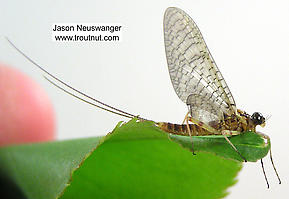 View 4 PicturesThis is the only Heptageniid mayfly I saw hatch on May 24, 2004, and luckily it floated right by me.
View 4 PicturesThis is the only Heptageniid mayfly I saw hatch on May 24, 2004, and luckily it floated right by me.
Edit: Gonzo confirmed most likely vicarium 06.21.12
 View 4 PicturesThis is the only Heptageniid mayfly I saw hatch on May 24, 2004, and luckily it floated right by me.
View 4 PicturesThis is the only Heptageniid mayfly I saw hatch on May 24, 2004, and luckily it floated right by me.Edit: Gonzo confirmed most likely vicarium 06.21.12
Collected May 24, 2004 from the Namekagon River in Wisconsin
Added to Troutnut.com by Troutnut on January 25, 2006
Added to Troutnut.com by Troutnut on January 25, 2006
Top 10 Fly Hatches
Top Gift Shop Designs
Eat mayflies.
Top Insect Specimens
Miscellaneous Sites
Troutnut.com is copyright © 2004-2024 Jason
Neuswanger (email Jason). See my FAQ for information about use of my images.
 privacy policy
privacy policy
